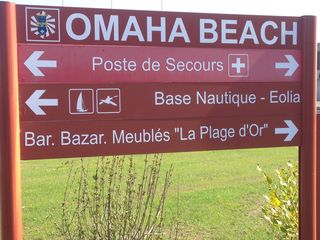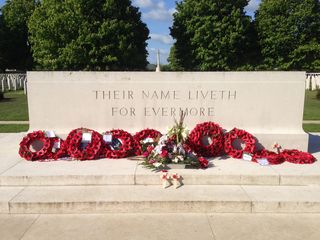When I think of a day at the beach, I think of umbrellas, children, swimming, and sunshine. June 6, 1944 was a very different picture at 6:30 a.m. when the “boys” from the 1st Infantry Division arrived riding Higgins boats on Omaha Beach. It was overcast and storming. The aircraft support troops could not fly in as planned to via an air raid, for fear of hitting the landing craft. The fleet of floating tanks that were expected to be waiting on the beaches, had sunk into the ocean five miles from shore, with only two reaching their destination.
 In the water, as well as on the sand, the troops encountered deliberately planted obstruction barriers to prevent the boats from reaching shore. The boats did reach the shore, albeit east of their intended landing place due to strong currents. Many of the men had to wade 50 – 100 yards in water up to their necks, carrying full gear, with guns held overhead, under heavy gunfire. Once reaching the sand, it was open-fire as the troops tried to make it to the multistory-high cliffs and scale them. The battle at Omaha beach took six hours before the Allied forces penetrated a gateway to get through, leaving carnage like no other. The visual I was provided by another was described as “miles of khaki and red” blending the blood with sand.
In the water, as well as on the sand, the troops encountered deliberately planted obstruction barriers to prevent the boats from reaching shore. The boats did reach the shore, albeit east of their intended landing place due to strong currents. Many of the men had to wade 50 – 100 yards in water up to their necks, carrying full gear, with guns held overhead, under heavy gunfire. Once reaching the sand, it was open-fire as the troops tried to make it to the multistory-high cliffs and scale them. The battle at Omaha beach took six hours before the Allied forces penetrated a gateway to get through, leaving carnage like no other. The visual I was provided by another was described as “miles of khaki and red” blending the blood with sand.
When I stood there looking out, the beach was quiet and beautiful. The weather was uncharacteristically sunny and warm with clear skies. The only artifacts left are damaged bunkers, grass-grown bomb craters, and the beaches with gorgeous green and blue water flowing in and out. My eyes were trying to see the tankers, ships and soldiers that remained underneath.
My time there was limited, but the memories are forever strong. I could have just turned and left, headed to the next historical site. But I couldn’t. I had to pause and silently say a prayer of honor for those who have served our country in all wars, and for their family members.
The men and women who have experienced war, as well as their families, change after their experiences. But those who study history in-person, not just in books, are changed too. I have always had an appreciation for my WWII clients. But the level of appreciation has heightened now that I have been able to visit the battle sights 70 years later.
 Don’t just remember D-Day in years to come, experience it and honor it. My next article will highlight the interview I had with Judge James Hill, WWII veteran.
Don’t just remember D-Day in years to come, experience it and honor it. My next article will highlight the interview I had with Judge James Hill, WWII veteran.
Victoria L. Collier, CELA, Elder Care Attorney, Co-Founder of Lawyers for Wartime Veterans and Lawyers with Purpose, Veteran, author of 47 Secret Veterans Benefits for Seniors and most recent book, Paying for Long Term Care: Financial Help for Wartime Veterans: The VA Aid & Attendance Benefit.



Add a Comment